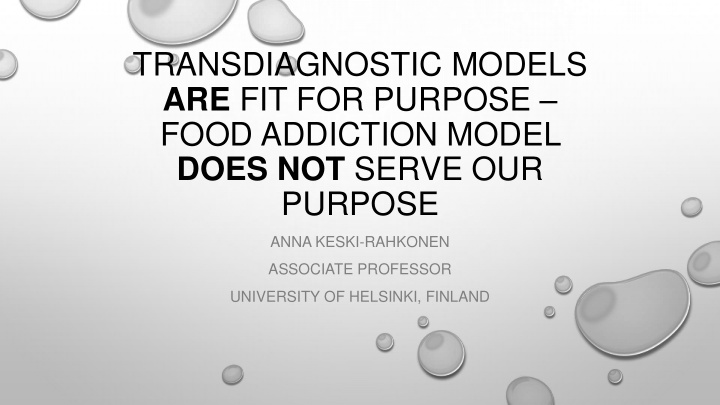



TRANSDIAGNOSTIC MODELS ARE FIT FOR PURPOSE – FOOD ADDICTION MODEL DOES NOT SERVE OUR PURPOSE ANNA KESKI-RAHKONEN ASSOCIATE PROFESSOR UNIVERSITY OF HELSINKI, FINLAND
WHAT I AM FOR: FOR EATING DISORDERS, TRANSDIAGNOSTIC MODELS FOOD ADDICTION MODEL
Transdiagnostic No ED 42 25 17 7 10 EDNOS AN models in Eating 16 22 13 7 BN 22 12 Disorders Fairburn & Harrison 2003 Orthorexia Body Muscle dysmorphia ( DSM-5, F 45.22) Bigorexia AN Restrictive + Purgative Bulimie BED and Night Eating Malnutrition BMI Obesity
RESEARCH EVIDENCE SAYS THAT TRANSDIAGNOSTIC MODELS OF EATING DISORDER TREATMENT WORK WELL CBT is the leading approach in the treatment of eating disorders in adults. CBT in different forms was already established as the front-line treatment for bulimia nervosa and binge eating disorder 13 . A series of studies 14 – 19 using CBT-E have demonstrated the following: • CBT-E is effective for normal-weight bulimia nervosa and atypical eating disorders; approximately half of patients remit and remain well. • Patients with anorexia do moderately well with CBT-E (approximately 30% entering treatment recover by the end of out-patient therapy, and a somewhat higher rate by the end of in-patient treatment). • CBT-E is more effective than interpersonal psychotherapy (IPT) and psychodynamic therapy for normal- weight cases. Waller G. Recent advances in psychological therapies for eating disorders F1000Research 2016, 5 (F1000 Faculty Rev):702 10.12688/f1000research.7618.1
WHAT PRACTICAL BENEFITS DO FOOD ADDICTION MODELS ADD TO CURRENT TREATMENTS? • IN TREATMENT OF SUBSTANCE USE, WE RESTRICT ACCESS TO ADDICTIVE SUBSTANCES. • Should individuals with eating disorders only have access to healthy food? Isn’t this called orthorexia nervosa? • WHICH NEW COMPONENTS DO ”FOOD ADDICTION ” TREATMENTS ADD TO EXISTING ONES? • IS THERE ANY EVIDENCE THAT ADDRESSING ”FOOD ADDICTION ” IMPROVES OUTCOMES?
I THINK THE FOOD ADDICTION MODEL IS JUST A BIT SILLY. If we account for food addiction in therapy, we should also account for other common behavioral addictions: Relationship addiction Love addiction Sex addiction Porn addiction Shopping addiction Internet addiction Phone addiction
WHAT IS THE UNDERLYING FACTOR IN ALL OF THESE ” ADDICTIONS ”? WHY DO WE CRAVE … Food Intimate relationships To feel better Love To get rid of Sex negative affect Beautiful things Distractions Time spent online
WE DO ALL KINDS OF SILLY THINGS TO WARD OFF NEGATIVE FEELINGS. TRANSDIAGNOSTIC TREATMENT ADDRESSES THOSE THINGS.
TRANSDIAGNOSTIC TREATMENT ADDRESSES EMOTION REGULATION. IT ALSO WORKS FOR MANY COMORBID ISSUES …
LET’S NOT ADD EXTRA CLUTTER OF QUESTIONABLE BENEFIT TO OUR TREATMENTS. WE ALREADY HAVE THE TRANSDIAGNOSTIC THEORY AND ALL THE TOOLS THAT WE NEED. LET’S VOTE AGAINST THE MOTION. FOOD ADDICTION MODEL
Recommend
More recommend